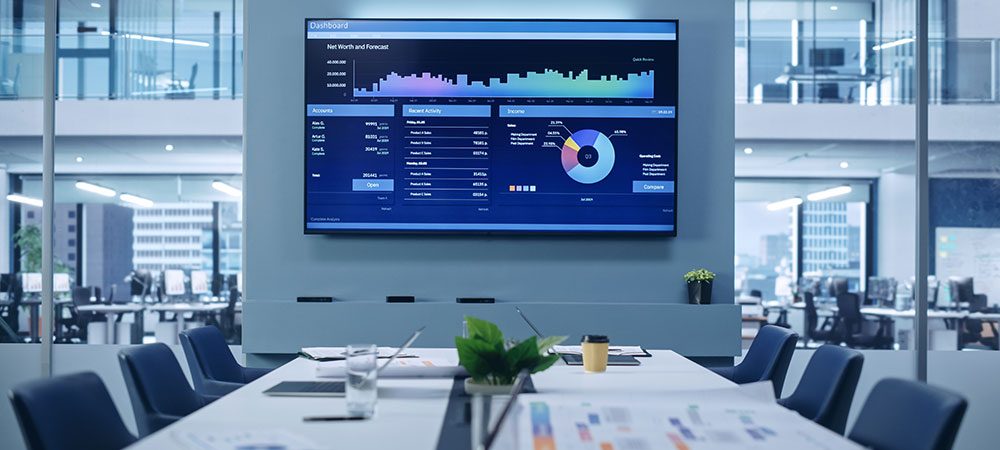Encouraging a metrics-driven mindset will help to create a culture of continuous improvement, says Ed Morgan, COO, DisplayNote. Here he offers his practical advice for capturing these essential metrics and three action points to help you get started on your journey towards meeting room software mastery.
In 1969, when Apollo 11 successfully landed on the moon, it was a testament to the power of mastering metrics. The mission relied on precise calculations and measurements for trajectory, fuel consumption and life support systems to ensure the safety of the astronauts and the success of their lunar landing. Just as meticulous attention to metrics was essential for that historic mission, mastering meeting room software metrics is crucial for organisations aiming to enhance collaboration and productivity in today’s fast-paced business environment.
Capturing key metrics
ROI
This metric is used to evaluate the financial efficiency of your investment in meeting room software. Calculating the Return-On-Investment (ROI) can help you demonstrate the value of your investment to stakeholders and justify future spending.
To calculate the ROI of your meeting room software, consider the following steps:
- Identify direct and indirect costs: Direct costs may include software licensing fees, hardware expenses and IT support, while indirect costs could encompass employee training and time spent on setup and maintenance.
- Quantify benefits: Assess the tangible and intangible benefits of the software, such as reduced travel expenses, improved productivity and enhanced collaboration.
- Calculate the ROI: Subtract the total costs from the total benefits and divide the result by the total costs. Multiply this figure by 100 to obtain the ROI percentage.
Meeting efficiency
This metric measures the overall effectiveness of your meetings in terms of agenda completion, decision-making and problem-solving. High meeting efficiency rates indicate that your meeting room software is facilitating productive discussions and helping teams reach their objectives.
To measure meeting efficiency, consider implementing the following practices:
- Establish clear objectives: Before each meeting, set specific, measurable, attainable, relevant and time-bound (SMART) goals.
- Monitor agenda completion: Track the percentage of agenda items completed during each meeting.
- Evaluate decision-making: Assess the effectiveness of problem-solving and decision-making during meetings by reviewing the quality and timeliness of decisions made.
Remote work enablement
This metric measures the extent to which your meeting room software supports remote work and distributed teams. High remote work enablement rates indicate that your software is effectively bridging the gap between in-person and remote collaboration.
To gauge remote work enablement, consider these strategies:
- Analyse connectivity and accessibility: Measure the percentage of remote employees who can seamlessly connect to the meeting room software and access all necessary resources.
- Survey remote/hybrid employee satisfaction: Regularly collect feedback from remote employees regarding their experiences with the software and its impact on their productivity and collaboration.
- Track remote work productivity: Monitor key performance indicators (KPIs) for remote employees, such as task completion rates and project milestones.
Kick-starting your metrics journey: Three action points to consider
To kick-start your journey towards meeting room software mastery, follow these three essential action points that will lay the foundation for capturing key metrics and driving continuous improvement.
Conduct a baseline assessment: Before implementing new meeting room software or making changes to your existing solution, assess your current performance using the metrics outlined above. This baseline will serve as a reference point for future improvements.
Communicate the importance of metrics to stakeholders: Inform employees, team leaders and other stakeholders about the key metrics you will be tracking and explain their relevance to the organisation’s overall success. Encouraging a metrics-driven mindset will help create a culture of continuous improvement.
Regularly review and refine metrics: As your organisation evolves and your meeting room software usage patterns change, periodically review and adjust your metrics to ensure they remain aligned with your business objectives. This process will help you identify areas for improvement and optimise your investment.
Conclusion
Just as the Apollo 11 mission demonstrated the vital importance of mastering metrics to achieve ground-breaking success, CIOs and IT leaders must harness the power of meeting room software metrics to drive collaboration and productivity within their organisations. By focusing on practical ways to capture key metrics such as ROI, meeting efficiency and remote work enablement, and implementing the essential action points outlined in this article, you can propel your organisation towards new heights in the ever-evolving business landscape.
Click below to share this article

